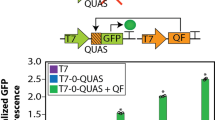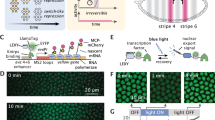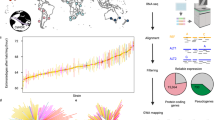Abstract
We established a transcription-based binary gene expression system in Caenorhabditis elegans using the recently developed Q system. This system, derived from genes in Neurospora crassa, uses the transcriptional activator QF to induce the expression of target genes. Activation can be efficiently suppressed by the transcriptional repressor QS, and suppression can be relieved by the nontoxic small molecule quinic acid. We used QF, QS and quinic acid to achieve temporal and spatial control of transgene expression in various tissues in C. elegans. We also developed a split Q system, in which we separated QF into two parts encoding its DNA-binding and transcription-activation domains. Each domain showed negligible transcriptional activity when expressed alone, but expression of both reconstituted QF activity, providing additional combinatorial power to control gene expression.
This is a preview of subscription content, access via your institution
Access options
Subscribe to this journal
Receive 12 print issues and online access
$259.00 per year
only $21.58 per issue
Buy this article
- Purchase on SpringerLink
- Instant access to full article PDF
Prices may be subject to local taxes which are calculated during checkout




Similar content being viewed by others
References
Gossen, M. & Bujard, H. Tight control of gene expression in mammalian cells by tetracycline-responsive promoters. Proc. Natl. Acad. Sci. USA 89, 5547–5551 (1992).
Brand, A.H. & Perrimon, N. Targeted gene expression as a means of altering cell fates and generating dominant phenotypes. Development 118, 401–415 (1993).
Lee, T. & Luo, L.Q. Mosaic analysis with a repressible cell marker for studies of gene function in neuronal morphogenesis. Neuron 22, 451–461 (1999).
Macosko, E.Z. et al. A hub-and-spoke circuit drives pheromone attraction and social behaviour in C. elegans. Nature 458, 1171–1175 (2009).
Davis, M.W., Morton, J.J., Carroll, D. & Jorgensen, E.M. Gene activation using FLP recombinase in C. elegans. PLoS Genet. 4, e1000028 (2008).
Bacaj, T. & Shaham, S. Temporal control of cell-specific transgene expression in Caenorhabditis elegans. Genetics 176, 2651–2655 (2007).
Potter, C.J., Tasic, B., Russler, E.V., Liang, L. & Luo, L.Q. The Q system: a repressible binary system for transgene expression, lineage tracing, and mosaic analysis. Cell 141, 536–548 (2010).
White, J.G., Southgate, E., Thomson, J.N. & Brenner, S. The structure of the nervous-system of the nematode Caenorhabditis elegans. Philos. Trans. Royal Soc., B 314, 1–340 (1986).
Miller, D.M. & Niemeyer, C.J. Expression of the Unc-4 homeoprotein in Caenorhabditis elegans motor-neurons specifies presynaptic input. Development 121, 2877–2886 (1995).
Spieth, J., Brooke, G., Kuersten, S., Lea, K. & Blumenthal, T. Operons in C. elegans polycistronic messenger RNA precursors are processed by transsplicing of Sl2 to downstream coding regions. Cell 73, 521–532 (1993).
Seydoux, G. & Fire, A. Soma-germline asymmetry in the distributions of embryonic RNAs in Caenorhabditis elegans. Development 120, 2823–2834 (1994).
Mello, C. & Fire, A. DNA transformation. Methods Cell Biol. 48, 451–482 (1995).
Nollet, L.M.L. Food Analysis by HPLC. Vol. 100 (CRC, 2000).
Clark, D.V., Suleman, D.S., Beckenbach, K.A., Gilchrist, E.J. & Baillie, D.L. Molecular cloning and characterization of the dpy-20 gene of Caenorhabditis elegans. Mol. Gen. Genet. 247, 367–378 (1995).
Zhang, S., Ma, C. & Chalfie, M. Combinatorial marking of cells and organelles with reconstituted fluorescent proteins. Cell 119, 137–144 (2004).
Luan, H., Peabody, N.C., Vinson, C.R. & White, B.H. Refined spatial manipulation of neuronal function by combinatorial restriction of transgene expression. Neuron 52, 425–436 (2006).
Giles, N.H., Geever, R.F., Asch, D.K., Avalos, J. & Case, M.E. The Wilhelmine E. Key 1989 invitational lecture. Organization and regulation of the qa (quinic acid) genes in Neurospora crassa and other fungi. J. Hered. 82, 1–7 (1991).
Ghosh, I., Hamilton, A.D. & Regan, L. Antiparallel leucine zipper-directed protein reassembly: application to the green fluorescent protein. J. Am. Chem. Soc. 122, 5658–5659 (2000).
Sym, M., Robinson, N. & Kenyon, C. MIG-13 positions migrating cells along the anteroposterior body axis of C. elegans. Cell 98, 25–36 (1999).
Hsieh, J. & Fire, A. Recognition and silencing of repeated DNA. Annu. Rev. Genet. 34, 187–204 (2000).
Frokjaer-Jensen, C. et al. Single-copy insertion of transgenes in Caenorhabditis elegans. Nat. Genet. 40, 1375–1383 (2008).
Luo, L., Callaway, E.M. & Svoboda, K. Genetic dissection of neural circuits. Neuron 57, 634–660 (2008).
Tursun, B., Cochella, L., Carrera, I. & Hobert, O. A toolkit and robust pipeline for the generation of fosmid-based reporter genes in C. elegans. PLoS ONE 4, e4625 (2009).
Gilleard, J.S., Barry, J.D. & Johnstone, I.L. cis-regulatory requirements for hypodermal cell-specific expression of the Caenorhabditis elegans cuticle collagen gene dpy-7. Mol. Cell. Biol. 17, 2301–2311 (1997).
Chelur, D.S. & Chalfie, M. Targeted cell killing by reconstituted caspases. Proc. Natl. Acad. Sci. USA 104, 2283–2288 (2007).
Brenner, S. The genetics of Caenorhabditis elegans. Genetics 77, 71–94 (1974).
Acknowledgements
This work was funded by the Howard Hughes Medical Institute. We thank M. Vanhoven (San José State University) for the unc-4c promoter and the wyEx1817 transgene, members of the E. Jorgensen laboratory for the MosSCI protocol, M. Nonet for the long-fragment PCR protocol, members of the Caenorhabditis Genetics Center for providing strains, C. Gao, T. Boshika and Y. Fu for technical assistance, and members of the Shen lab for comments on the manuscript.
Author information
Authors and Affiliations
Contributions
X.W. and K.S. designed the experiments and wrote the paper. X.W. performed all experiments and data analysis. L.L. and C.J.P. provided unpublished information on the Q system and guided experimental design.
Corresponding author
Ethics declarations
Competing interests
The authors declare no competing financial interests.
Supplementary information
Supplementary Text and Figures
Supplementary Figures 1–5, Supplementary Table 1, Supplementary Notes 1–3 (PDF 718 kb)
Rights and permissions
About this article
Cite this article
Wei, X., Potter, C., Luo, L. et al. Controlling gene expression with the Q repressible binary expression system in Caenorhabditis elegans. Nat Methods 9, 391–395 (2012). https://doi.org/10.1038/nmeth.1929
Received:
Accepted:
Published:
Issue date:
DOI: https://doi.org/10.1038/nmeth.1929
This article is cited by
-
NanoBRET in C. elegans illuminates functional receptor interactions in real time
BMC Molecular and Cell Biology (2022)
-
Enhanced regulation of prokaryotic gene expression by a eukaryotic transcriptional activator
Nature Communications (2021)
-
IQ-Switch is a QF-based innocuous, silencing-free, and inducible gene switch system in zebrafish
Communications Biology (2021)
-
A novel in vitro Caenorhabditis elegans transcription system
BMC Molecular and Cell Biology (2020)



